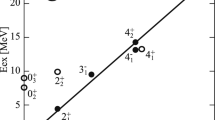Abstract
In early work of March and Young (Phil Mag 4:384, 1959), it was pointed out for spin-free fermions that a first-order density matrix (1DM) for \(N-1\) particles could be constructed from a 2DM (\(\Gamma \)) for \(N\) fermions divided by the diagonal of the 1DM, the density \(n(\mathbf{r}_1)\), as \(2\Gamma (\mathbf{r}_1,\mathbf{r}^{\prime }_2;\mathbf{r}_1,\mathbf{r}_2)/n(\mathbf{r}_1)\) for any arbitrary fixed \(\mathbf{r}_1\). Here, we thereby set up a family of variationally valid 1DMS constructed via the above proposal, from an exact 2DM we have recently obtained for four electrons in a quintet state without confining potential, but with pairwise interparticle interactions which are harmonic. As an indication of the utility of this proposal, we apply it first to the two-electron (but spin-compensated) Moshinsky atom, for which the exact 1DM can be calculated. Then the 1DM is found for spin-polarized three-electron model atoms. The equation of motion of this correlated 1DM is exhibited and discussed, together with the correlated kinetic energy density, which is shown explicitly to be determined by the electron density.


Similar content being viewed by others
References
P.O. Löwdin, Phys. Rev. 97, 1474 (1955)
A.J. Coleman, Rev. Mod. Phys. 35, 668 (1963)
N.H. March, W.H. Young, Phil. Mag. 4, 384 (1959)
W.H. Young, N.H. March, Proc. R. Soc. (London) A256, 62 (1960)
See also N.H. March, G.G.N. Angilella. Many-Body Theory of Molecules, Clusters and Condensed Phases (World Scientific, Singapore, 2010)
L.W. Bruch, J. Chem. Phys. 72, 5511 (1980)
N.H. March, Phys. Lett. A 306, 63 (2002)
C. Amovilli, N.H. March, Phys. Rev. A 83, 044502 (2011)
A. Akbari, C. Amovilli, N.H. March, A. Rubio, Chem. Phys. Lett. 536, 162 (2012)
M. Levy, A. Gorling, Phil. Mag. B69, 763 (1994)
See also N.H. March, J. Mol. Struct. (Theochem), 943, 77 (2010)
R.G. Parr, W. Yang, Density Functional Theory of Atoms and Molecules (Oxford University Press, New York, 1989)
C. Amovilli, N.H. March; in course of publication (2012)
Acknowledgments
N. H. March (NHM) wishes to acknowledge the major contributions made to his understanding of the general area in which this study lies by Professors W. H. Young and C. Amovilli over some decades. Most generous hospitality of Professor P. M. Echenique at DIPC has made possible NHM’s contribution to the present study. Also his continuing affiliation with the University of Antwerp (UA) is due to support from Professors D. Lamoen and C. Van Alsenoy through BOF-NOI(UA). We acknowledge financial support from the European Research Council Advanced Grant DYNamo (ERC-2010-AdG, Proposal No. 267374), Spanish Grants No. FIS2011-65702-C02-01 and No. PIB2010US-00652, ACI-Promociona (Grant No. ACI2009-1036), Grupos Consolidados UPV/EHU del Gobierno Vasco (Grant No. IT-319-07), Consolider nanoTHERM (Grant No. CSD2010-00044), Fondo Social Europeo (FSE) and the Spanish Research Council (CSIC) through their Junta para la Ampliación de Estudios fellowship (JAE-Predoc-2008).
Author information
Authors and Affiliations
Corresponding author
Appendix: Some technical details relating to Section 2
Appendix: Some technical details relating to Section 2
The Moshinsky wave function in Eq. (6) is written completely in terms of two quantity \(C_1\) and \(C_2\) and the normalization constant \(C\). These are given below explicitly in terms of the force constant \(k\) of the external potential and \(K\) for the interparticle interaction \(u(r_{12})\):
Next, We turn to the density \(n_1\) in Eq. (12). We summarize below a spherical family of one-level electron densities and the corresponding one-body potential. This family is constructed explicitly by multiplying Eq. (12) by volume element \(d\Omega \) and integrate over the angle between \(\mathbf{r}_1\) and \(\mathbf{r}_2\) to find
With this density \(\bar{n}_1\) inserted for \(n\) in the von Weizsäcker Eq. (13) we extract the one-body potential \(\bar{V}(\mathbf{r}_2;\mathbf{r}_1)\) to within an additive constant, as
This means that the Schrödinger equation can be solved exactly for this potential \(\bar{V}(\mathbf{r}_2;\mathbf{r}_1)\) for arbitrary \(\mathbf{r}_1\), the corresponding wave function \(\bar{\Psi }\) being simply the square root of the right hand side of Eq. (39). Figure 2 depicts the general shape of the potential in Eq. (39) for a particular choice of \(C_2 r_1\) and \(C_1\).
Rights and permissions
About this article
Cite this article
Akbari, A., March, N.H. & Rubio, A. A proposed family of variationally correlated first-order density matrices for spin-polarized three-electron model atoms. J Math Chem 51, 763–773 (2013). https://doi.org/10.1007/s10910-012-0113-8
Received:
Accepted:
Published:
Issue Date:
DOI: https://doi.org/10.1007/s10910-012-0113-8




